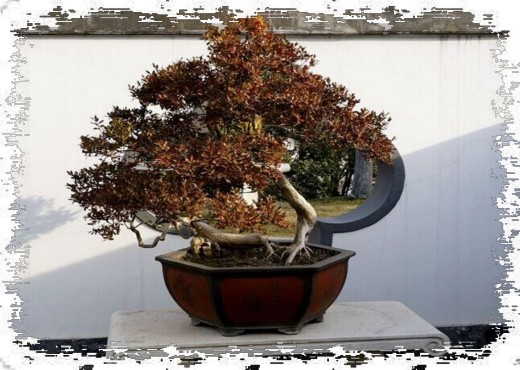Master-slave relationship in bonsai creation
Primary and secondary, also known as "principal and subordinate", "principal appreciation (object)", "partial perfection" and so on, is one of the important laws of formal beauty. In any work of art, the relationship between each department cannot be equal, and there must be a distinction between the primary and the secondary.

In the creation of bonsai, we should also highlight the subject and object, so there should be a clear distinction between the host and the guest. Such as a bonsai of mountains and rivers, how to deal with the relationship between guest and host? The relationship between the main mountain and the mountains should be like the relationship between grandparents and grandchildren. The main mountain is the ancestral mountain, which should be solemn and dignified, looking forward to affection, and the mountains, like children and grandchildren, should be respectfully obedient and should not go their own way. There should be a great difference in height and volume between the main mountain and the guest mountain in order to achieve the effect of Yuxing Gongyue.
Which scenery is the main body?
Mountains, water, trees and stones can all be used as the main body. For example, the bonsai of Su Dongpo's "Shuangshi" and Lu you's "Lao Xue Nunnery" are all dominated by mountains, while "the Yangtze River runs through the mountains" and "the Yangtze River flows to the horizon" are all dominated by water. In the pile scenery of Lingnan bonsai or Guangxi bonsai, there is a narrow distinction between the subject and the object of the double-dry or multi-dry style, while in other forms, such as the cliff type, the subject is the tree and the guest is the stone in the soil; on the contrary, if it is a basin of landscape bonsai, it is dominated by stone, and the trees born in the mountains and rocks are the guests; as for the straight-dry pile landscape, the trees are mainly trees and the accompanying linings are the objects.
From the forest-style bonsai, also with trees as the main body, the stones in the basin, some symbolize the mountains and create meaning, but also as strange stones (strange stones can also be used as the main body). In the performance of the forest scenery, there are several trees in a clump, and there should also be a clear distinction between the guest and the host. For example, in a clump of three trees, the first tree is the main tree, and the second and third trees are guest trees.
What is the main tree? Shen Shuyang wrote in the New Theory of Grammar of traditional Chinese painting: "is the main tree whose root is at the bottom?" The master is also near the tree. If the main tree is straight, the guest tree is straight, and the main tree is straight, then the guest tree must not be reversed. The main tree is full of trees, so let the guest tree be straight. Bonsai main tree modeling, not only the posture should be high-dry guest tree, but also the height and shape should be higher than the guest tree, in order to make the main scene prominent, so that the isolated peak-style landscape bonsai, there seems to be only the main body but no guests. However, as far as the interior is concerned, there is still a distinction between primary and secondary, such as the difference between the trunk and the side branches of the tree. Therefore, the object in these works can also be felt and supplemented by the viewer's imagination.
Time: 2019-05-23 Click:
- Prev

There are some skills in the display of family bonsai.
There are also certain skills for the display of family bonsai, here we mainly talk about the display of bonsai from the following aspects: 1. The display of different types of bonsai: bonsai trees should be placed on the horizon. You can enjoy the panoramic view of the tree and the sense of perspective.
- Next

The artistic style characteristics of Jinling Bonsai
Bonsai is a traditional art in China with a long history. It originated in Tang Dynasty, developed in Song Dynasty and flourished in Ming and Qing dynasties. Among them, Jinling bonsai has a rich artistic style and distinctive features, which depends on the production materials and skills. First, Jinling bonsai materials, focusing on local endemic or suitable for local growth of plants and local mountains and rocks
Related
- Fuxing push coffee new agricultural production and marketing class: lack of small-scale processing plants
- Jujube rice field leisure farm deep ploughing Yilan for five years to create a space for organic food and play
- Nongyu Farm-A trial of organic papaya for brave women with advanced technology
- Four points for attention in the prevention and control of diseases and insect pests of edible fungi
- How to add nutrient solution to Edible Fungi
- Is there any good way to control edible fungus mites?
- Open Inoculation Technology of Edible Fungi
- Is there any clever way to use fertilizer for edible fungus in winter?
- What agents are used to kill the pathogens of edible fungi in the mushroom shed?
- Rapid drying of Edible Fungi

